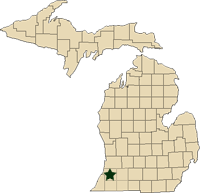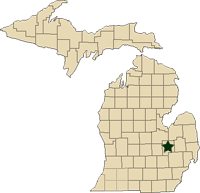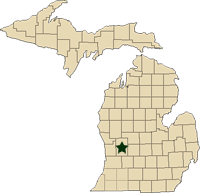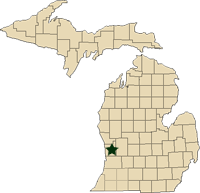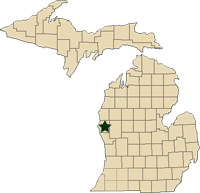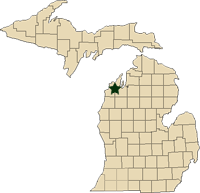Regional reports on Michigan fruit - May 17, 2011
MSU Extension educators’ pest and fruit updates for Michigan.
This week’s regional reports:
- Southwest Michigan
- Southeast Michigan
- Grand Rapids Area Tree Fruit
- Grand Rapids Area Small Fruit
- West Central Michigan
- Northwest Michigan
Southwest Michigan – Mark Longstroth, Bill Shane and Diane Brown; Michigan State University Extension
|
Weather
The last week was hot, with highs in the 80s. Strong storms moved though the region Wednesday (May 11), causing fire blight infections in apples and pears and mummy berry shoot strikes in blueberries. Cold rain on Friday lasted into Sunday evening, making the weekend cold and wet. Rainfall totals across the region were from 1 to 3 inches. This week will be cooler with continued cloudy rainy conditions. Temperatures should rise into the 70s by Thursday and a warm weekend in forecast. The warm weekend should provide an excellent apple thinning window. Soils are very wet. Soil temperatures are in the mid-50s. Despite the near record heat we are still behind average for fruit development. Check for the closest weather station at Enviro-weather.
| Southwest Michigan Growing Degree Day Totals from March 1 through May 15 | |||
| Location | GDD 42 | GDD 45 | GDD 50 |
| SWMREC | 435 | 330 | 214 |
| Trevor Nichols | 382 | 292 | 180 |
Tree fruit
The short, hot bloom period left a short pollination window and this week’s cooler weather will make assessing fruit set a problem for a while. The hot weather increased insect activity. Plum curculio is out, but is not a worry until stone fruit emerges from the shuck, allowing the females to lay their eggs in the fruit. Warmer conditions this weekend will be the time to protect fruit. Oriental fruit moth was biofixed on May 8 and egg laying has begun. The cool temperatures of the next few days should keep oriental fruit moth egg laying and other insect activity to a minimum until warm weather returns later this week.
Apricots are emerging from the shuck. The largest fruit are 10 mm in diameter.
Peaches are generally in the shuck. Shoots are 4 inches long and leaves are unfolding. Crop potential is excellent. Peach leaf curl symptoms are showing up in area orchards. Copper programs to suppress bacterial spot are continuing in some area orchards. Controls for oriental fruit moth should be applied soon in young peach orchards where pheromone disruption is not being used. Plum curculio will be a concern after the fruit emerge from the shuck.
Sweet cherries are emerging from the shuck. The largest fruit are 8 mm in diameter. Sweet cherries are always susceptible to brown rot infection in warmer rains. Sweet cherries are also susceptible to cherry leaf spot. The cherry leaf spot fungus has developed resistance to many of the most effective fungicides.
Tart cherries are at petal fall and in the shuck. Balaton cherry bloom is over. Tart cherries are generally resistant to brown rot except during bloom and fruit ripening. Cherry leaf spot is a major cherry disease in Michigan “Montmorency” cherries, and this weekend’s rain was a heavy cherry leaf spot infection period.
In plums, Japanese plums are in the shuck and fruit set is generally poor. European plums are in the shuck. Growers need to maintain black knot controls during shoot growth. Plum curculio is a concern after shuck split.
Apple bloom is ending. Most varieties were in full bloom last Wednesday and are at petal fall now. Thunderstorms last Wednesday probably caused fire blight infections on Wednesday, Thursday and perhaps Friday. Many growers had applied antibiotics earlier in the week and used Kasumin on Wednesday or Thursday. The interactive fire blight tool on Enviro-weather can be used both to forecast the infection risk and when symptoms will appear.
Apple scab symptoms from April infections (April 15, 22, 25 and 27) are easy to find on unsprayed trees. Apple scab spore production has peaked but not all the spores have been released. It is important to maintain fungicide coverage. Growers can use the scab infection tool on the Enviro-weather website to track infection periods.
Powdery mildew is a concern on susceptible varieties. Apple thinning will be poor this week but a good thinning window with highs into the upper 70s is forecast for this weekend.
Insect activity in apples has been low due to the cool temperatures. Growers should check for obliquebanded leafroller larvae. Plum curculio and tarnished plant bug are concerns when temperatures rise higher and fruit start growing.
Pear bloom is ending. The major pear varieties are susceptible to fire blight and pear scab which is similar to apple scab. Pear growers should use the apple tools for these diseases to help plan their control strategies. Pear psylla egg laying was heavy during the hot weather.
Small fruit
Grape shoots are about 4 inches long and generally two leaves have unfolded, exposing the flower clusters. The danger of insect damage from cutworms and grape flea beetle has past. During the shoot growth period before bloom, the primary focus is on disease control. Many grape growers were applying their first or second fungicide sprays. It is important to get fungicide applications on early to control phomopsis infections as the flower clusters are exposed.
Blueberries are blooming. Early varieties such bluetta are at full bloom. Bluecrop is at 30 to 50 percent bloom. Jersey and Elliot have not yet opened. After the weekend rain, fields are soaked again with water standing in many fields. The bloom appears light in many fields. Mummy berry shoot strikes have appeared in Berrien and Van Buren counties. Blueberry flowers will be susceptible to infection during pollination.
Few, new trumpets have emerged, and only a few trumpets still appear to be viable. Growers should be using Indar which is the most effective material against both shoot and flower infections. Applications should be timed for 10 percent and 50 percent bloom. Traps for cranberry fruit worm and cherry fruit wormfruitworms. Obliquebanded leafroller feeding has been reported in flower clusters. should be out to determine biofix and allow the use of the Enviro-weather models for fruitworms. Obliquebanded leafroller feeding has been reported in flower clusters.
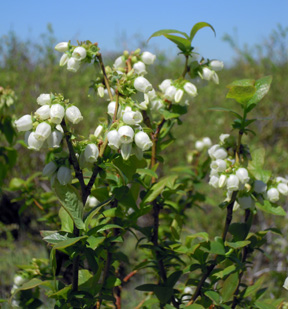
Mummy berry shoot strikes near South Haven.
Strawberry bloom has begun. Some growers protected their fields from Monday morning’s frost, and there was some damage in unprotected fields. The critical temperature for freeze damage during bloom is 28°F. Growers should begin monitoring for tarnished plant bug. Temperatures have been warm enough for adult activity, and adults begin laying eggs once temperatures get to 68°F or higher. Feeding by tarnished plant bug can cause death of the flowers or deformed fruit (button berries).
Brambles shoots are about 4 inches long. New primocanes in fall bearing raspberries are still only a few inches high.
Southeast Michigan – Bob Tritten, Michigan State University Extension
|
Weather
Warm temperatures late last week on Wednesday (May 11), Thursday and Friday quickly moved our season ahead, back toward normal. For apple growers, this warm and wet weather brought a severe threat of fire blight infection for varieties that were in blossom. Over the weekend the weather situation turned 180 degrees with excessive rains in some areas, very windy and cold temperatures.
Many of our agriculture weather reporting stations across the region reported five wetting events in the last seven days. Rainfall totals over the week were in the range of 2 to 4 inches. In the southern tier of counties, rainfall totals were about 1.5 to 2.5 inches, and through the Thumb with rainfalls around 0.5 inches.
Soil moisture levels are high in most parts of the region, bringing field operations to a halt, with the exception of spraying. Speaking of spraying, it has been difficult for tree fruit growers to keep fungicides and bactericides current due to the number of wetting events, wet soils and very windy conditions.
Even with the warmth of last week, our season is running nearly a week behind normal when I look at growth stages and a little bit more than a week when I look at degree day totals.
For both tree and small fruits that were planted prior to last weekend’s rain events, plant growth has taken off. There is no doubt that trees planted before the rain events of last weekend are well settled into the soil. It was nice to see just yesterday newly planted strawberries that are starting to grow; you can begin to row the strawberries quite nicely now.
Many tree fruits were either in full bloom or approaching bloom when the cold and windy weather hit over the weekend. I would share that for the most part, the flowers on tree fruits that were in bloom look ragged and rough as a result of rain, wind and cold over the weekend. They really took a beating through the process. It was even hard to tell when petal fall was actually taking place. For these crops, I am concerned about the effects of this weather on pollination. For tree fruits that were in bloom on Wednesday, Thursday or Friday last week when we had warm temperatures, I don’t feel that there is much of a concern about the effect of cold, windy, wet weather on pollination. It was those tree fruit crops that were approaching bloom that I am most concerned about. For example, in the Flint area, tart cherries were just coming into bloom late in the day on Friday. With the amount of rain, cold and wind that we had over the weekend, most of those flowers that opened will have been damaged or are not capable of pollinating. The best that I can tell you at this time is that we will just have to “wait and see.”
Frost has not been an issue at any fruit farms across the region. With warmer morning low temperatures predicted over the next week, I think that we are beyond the point of being susceptible to frost or freeze damage. Strawberry growers have not needed to frost protect as of yet, and it now appears that it may be possible for them to move through this first part of bloom without any frost protection needed. Here again, time will tell.
We are a bit off cycle in terms of blooming and leaf growth development in many of our fruit crops this year. There has been a fair amount of foliage developed at the same time as flowering. This has given the appearance that there hasn’t been good bloom in many of our fruit crops; however, the blossom has been hidden due to this early development of foliage. I don’t think this is a concern, just a curiosity more than anything else.
| Southeast Michigan Growing Degree Day Totals for March 1 to May 16 | |||
| Location | GDD42 | GDD45 | GDD50 |
| Commerce (Oakland) | 377 | 289 | 178 |
| Emmett (St. Clair) | 356 | 270 | 163 |
| Flint (Genesee) | 397 | 304 | 192 |
| Lapeer (Lapeer) | 389 | 301 | 190 |
| Petersburg (Monroe) | 439 | 335 | 203 |
| Pigeon (Huron) | 302 | 288 | 177 |
| Romeo (Macomb) | 352 | 266 | 159 |
Tree Fruits
Apples are at full bloom for most varieties in the mid part of east Michigan, with Northern Spys being at king bloom. I am getting a few reports from growers who were fortunate enough to have a heavy crop of apples last year that return bloom may be on the light side this season for some varieties.
We now have about 2 to 3 inches of new growth on apples in the Flint area, so now is the perfect time to begin Apogee applications.
Many apple growers report oriental fruit moth trap catches have continued to climb over the last week. Many growers biofixed for oriental fruit moth mid-week of last week. I am setting the regional biofix date for oriental fruit moth of May 11.
Spotted tentiform leafminer trap catches are generally down across the region, as they are now between first and second generation adult flight. I am continuing to see egg laying of spotted tentiform leafminer.
Redbanded leafroller trap catches are down, although I continue to see low numbers of larvae of not only redbanded leafroller, but also green fruitworm and fruit tree leafroller.
Plum curculio has been found in the last day or two. While it is too early to see plum curculio damage, I am finding it while beating limbs. Not only am I seeing them in apple, but peach as well.
I started to see leaf curling at low levels from rosy apple aphids. I continue to see a few apple grain aphids. I have not seen any tarnished plant bugs in apples, but would expect to see some in the next few days. I am finding them in peaches. I had a report from a scout late last week that one white apple leafhopper was found. That is very early in the season to find this insect. I have not seen any crawlers yet of San Jose scale. I have not seen any woolly apple aphid, but they are starting to become active under bark shields.
Last week certainly was a traumatic one in terms of three days of heavy fire blight infection potential and then an extended wetting and infection period for apple scab over the weekend. I continue to catch increasing numbers of apple scab spores with each wetting event. Typically, bloom time is the time of maximum spore catch for apple scab. Most growers have remained covered for apple scab, although it has been quite a challenge with windy conditions. Several of our weather stations report having five wetting events in the last week; most had one, and some two infection periods in the last week. No apple scab lesions have been seen on leaves as of Monday. The chances of infection from fire blight were very high last Wednesday, Thursday and Friday, but have dropped dramatically with the cold weather as of Saturday and Sunday. Many apple growers applied two or three applications of streptomycin over that time period. Remember that streptomycin does not translocate into the flower when sprayed prior to the blossom opening. Over the three-day time period last week, we had so many new blossoms opening each day that it was difficult for us to keep on top of fire blight. Powdery mildew shoot strikes are just starting to be seen in apples.
Pears are at full bloom. Pear psylla egg laying continues and increased in tempo during warm weather of late last week. It looks like we have a nice crop of pears coming on this year.
Peaches are at petal fall and are still in the shuck. As mentioned earlier, many growers biofixed for oriental fruit moth mid-week of last week. As mentioned in the apple section, both plum curculio and tarnished plant bugs were seen in low levels yesterday. It appears that we have a nice crop of fruit in the peaches this season. This is a year that peaches could be pruned back more severely than normal to reduce their height while we have such a big crop coming along. If a good number of peaches were pollinated last week when they were in bloom, it is going to present a thinning challenge for many growers this year.
Sweet cherries are at petal fall and some are growing so quickly that we are starting to be at shuck split at this time. Most sweet cherries appear to be well pollinated.
Tart cherries are at full bloom to early petal fall, although it is a bit hard to tell due to the blossom being beaten up so badly in weekend weather. I have already talked about my concern about tart cherry pollination in many blocks as they were just coming into bloom as cold weather hit over the weekend.
Plums are at petal fall for European plums and Japanese plums are between petal fall and shuck split.
Small fruits
Strawberry rows have filled out quite nicely over the last week, with a great deal of new leaf growth that looks more toward normal. On newly planted strawberries, growth is finally starting to take place. In the southern part of the region we have about 15 to 20 percent bloom in strawberries, and in the Flint area about 1 percent, with none to the north. It appears that it will be a very late season for strawberry farms across the region.
Wet soils are a concern to me in strawberries; this increases the likelihood of seeing issues with black root rot later in the production cycle. Yesterday, I started to find slugs in the wet mulch under strawberries. I also saw my first damage from strawberry clipper for the season. Weeds continue to be a problem in some strawberry fields, particularly grassy weeds from straw mulch. Most growers in the south have not needed to frost protect strawberries. In looking at the long range weather forecast for the next seven days, it does not appear that frost will be an issue in strawberries.
Raspberries have about 1 to 3 inches of new shoot growth for summer red and black raspberries. Flower buds are now emerging from some of those shoots. Fall bearing raspberries have about 6 inches of new growth and new foliage looks really rough after the weekend of rain and wind. Blackberry growth is about 8 to 10 inches in length.
Blueberries are at late pink bud for most varieties. I saw my first open blossom on blueberries as of yesterday, but it was few. I have not seen any new trumpets from mummyberry disease. I have also been on the lookout for shoot strikes from mummyberry disease, but haven’t seen any as of yesterday.
Grapes are at 2 inches of new shoot growth for Concord types and French hybrids are still at late bud burst.
Grand Rapids Area Tree Fruit – Amy Irish-Brown and Phil Schwallier, Michigan State University Extension
|
Tree fruit growth stages
The weather has been a bit of a rollercoaster ride over the last 10 days – from colder than normal temperatures to a couple of days of 85 degrees and then back to highs barely above 50. Rainfall has been adequate to a bit too much to get field work accomplished. In general, degree day totals indicate we are three to five days behind normal averages. Apple growth is from king bloom on late blooming varieties to early petal fall on early blooming varieties.
Tree fruit pests
Apple scab. Over the past week, there were one or two scab infections depending on location. All areas had a major scab infection from rains on May 13, 14 and 15. Apple scab ascospore numbers were over 1,100 per rod which is a high number for this year’s monitoring. It is estimated that at the time of this rain, about 75 percent of ascospores were mature. It is estimated that we will reach 100 percent spore maturity around May 25 and it will take several rain events to discharge them beyond then. Scab cover sprays are still critical to maintain in apples for several weeks. The first scab lesions were found on May 15 and are most likely from the heavy infection back on April 26.
Fire blight was a concern with the rains last week and the 85 degree temperatures. Gingergolds and Ida Reds were mostly in full bloom at that time and needed to be protected for blossom blight. Galas were at king bloom and needed protection as well. The weather cooled quickly Saturday (May 14) into Sunday, eliminating the risk for blossom blight for much of this week. Forecasted temperatures for the coming weekend, May 27-28, will again be high enough to make blossom blight a concern again for anything with viable open bloom left. Growers are now putting on their first Apogee sprays for shoot growth control and blossom blight control.
Insect development in apples has started to pick up. Spotted tentiform leafminer is flying regularly; no tissue feeders have been found yet. Green fruitworm adult flight should be winding down; larvae can be found occasionally feeding in terminals. Oriental fruit moth began flying last week and a biofix was set for the general Grand Rapids area for May 12; early egg hatch is expected to begin early next week. Obliquebanded leafroller larvae are becoming easier to find in apple terminals, but numbers are not alarming. Initial European red mites hatch began last week. Rosy apple aphids are easier to find and were targeted at pink. Traps should be up for codling moth; first adult flight will most likely begin the end of this week or over the weekend. Mating disruption needs to be in place for codling moth coding and oriental fruit moth. Plum curculio activity in apples could begin at any time.
Apple crop management tasks this week include:
- First Apogee applications at king bloom petal fall or 3 inches of shoot growth.
- Foliar fertilzers including Nitrogen, Boron, Zinc and Calcium sprays. Do not mix calcium with Apogee.
- Provide on varieties where typier fruit is desired.
- Petal fall thinning for early setting varieties. Separate thinning and Apogee by several days.
Grand Rapids Area Small Fruit - Carlos García-Salazar, Michigan State University Extension
|
Weather conditions in the central region have improved with respect to the previous week. Minimum temperatures observed in the area for the past five days ranged from 34 to 58°F with an average temperature of 49°F. Meanwhile, maximum temperatures reached the lower 80s with an average temperature of 72°F. Some growers in Allegan and Ottawa counties are reporting spring frosts, which occurred over the weekend. Reports indicated that in some places temperatures were between 30 and 31°F for a short period of time. Regarding precipitation, there were several days with rains that left an accumulation that ranged from 1.87 to 2 inches of precipitation. These rains have interfered with the early disease management activities in blueberries.
As a result of the increase in daily temperatures, there was also an increase in the Growing Degree Day accumulation (GDD) in the region. Degree day accumulation by May 17 reached 202 GDD (base 50°F) and 420 GDD (base 42°F). Despite the observed improvement in environmental conditions, that GDD accumulation remains lower than the previous season. In 2010, GDD accumulation for May 17 was 309 GDD (base 50°F) compared with the 202 GDD accumulated so far. Because of this difference, plant growth and development remains more than one week behind with respect to the 2010 growing season.
At this time, late summer raspberries are in the leaf unfolding stage while early season are already in the flower bud stage. On the other hand, fall raspberries are in the cane emerging stage. So far, there is no evidence of insects or disease problems and their growth is very healthy.
For strawberries, in late season varieties flower trusses emerged from the crown and are clearly visible. Early varieties, on the other hand, are in the white bud and first flower stages. No diseases on insect problems are present.
Blueberry growth stages in the central region go from late pink bud in late season varieties (Elliott) to 10 percent bloom in the most advanced varieties like Bluecrop.
Major problems observed across the central region are related to winter damage. Damage is more evident in Jersey fields in Allegan County and in blueberry fields north of Ottawa County. These fields require extensive pruning of damaged tissues and fungicide treatment to prevent cankers. It is important to mention that blueberry fields that in 2010 presented plants with cankers due to phomopsis or mummy berry shoot strikes are presenting excessive dieback in 2011 after being exposed to the intense winter. Fields with a few cankers show little or very limited winter damage. It seems that weak plants or shoots are more susceptible to winter damage than healthy plants.
Regarding blueberry diseases, mummy berry mushrooms are drying out and no new apothecia are observed. Mummy berry shoot strike have been reported, but in fields scouted in Allegan and Ottawa counties the infection has not been observed, yet. For fields that are showing extensive dieback due to winter damage, it is important to maintain an active disease control program to prevent further damage. Fields affected by spring frosts always get secondary infections by phomopsis, which uses damaged tissues as a port of entry. If you see dieback problems in your field and you are not sure if this is due to winter, mummy berry or phomopsis, please call your local county Extension office for assistance or take shoot samples and send them for identification to the MSU Diagnostics Lab. Products recommended for early season mummy berry and phomopisis control are Indar 2F (6 fl oz) or Indar 75 WSP (2 oz) or Orbit (6 fl oz). For a complete list of products and recommendations for mummy berry and phomopsis control, please follow MSU Extension Bulletin E-154, 2011 MI Fruit Management Guide.
With respect to insect pest problems in blueberries, there will be enough degree day accumulation during the rest of the week to start the emergence of cherry fruitworm, especially in the Allegan area. At this time, cherry fruitworm traps should be in place to detect the beginning of the emergence of the overwintering adults. Timely detection of sustained moth catch is necessary to synchronize our pest control measures with the cherry fruitworm egg-lying period. This is important for fields with a history of cherry fruitworm infestations.
On May 25-26, we will be conducting our third Good Agricultural Practices for food safety in berry production program. The classroom program will be conducted at the Trevor Nichols Research Complexspace is limited, you must pre-register by contacting Judy Hanson at 616-994-4548 at the MSU Extension Ottawa County office in West Olive. in Fennville, Mich., and the hands-on activities will be conducted at farms of growers attending the workshop. There is a $150 registration fee for the first person and $100 for the second participant from the same farm. This includes lunch and educational materials. There will be a limited number of scholarships for growers unable to pay the full registration fee. Since
On June 1, we will be hosting another training workshop for berry growers interested in learning about the biology, monitoring and control of the spotted wing Drosophila. Growers, berry crop scouts and IPM consultants should attend this workshop. Training will start with classroom training followed-up by field hands-on training by MSU experts on this new invasive insect. Participants will learn about how to identify this new insect, how to trap for it, and how to sample fruit. This program is designed for growers, scouts and consultants to learn about spotted wing Drosophila before the field season starts, so management of this pest can be integrated into IPM programs. This training will be conducted at the Trevor Nichols Research Center, 6237 124th Avenue, Fennville, MI 49408. There will be a $25 registration fee, which includes lunch and educational materials.Space is limited so you must pre-register by contacting Judy HansonMSU Extension Ottawa County office in West Olive. at 616-994-4548 at the
West Central Michigan – Mirjana Bulatovic- Danilovich, Michigan State University Extension
|
Weather and crop development
Last week we experienced very unsettled weather pattern throughout the area. We had rain, hail, strong wind and extremely hot temperatures on Wednesday (May 11) and Thursday, followed by the significant cool down over the weekend and beyond. Wednesday morning a rather intense hailstorm hit parts of Mason County. Marble-sized hail created a trauma event that caused concern, particularly among apple, pear and sweet cherry producers. Following the hailstorm, temperatures rose into high 70s and into the mid-80s the next day. The weather changed for the weekend to cool, almost cold, conditions with a whole-day wetting event for Saturday. Sunday night there was a frost-freeze advisory. Though our Enviro-weather weather stations did not show below freezing temperatures, there was frost on the ground in low-lying areas and known frost pockets. Monday night with clear sky is yet another potential for frost, keeping everybody on the edge given the stage of tree fruit development.
Tree fruit
Apples are from full pink (McIntosh) to king bloom (Idared), depending on variety. Pears are in full bloom. Sweet cherries are from full bloom to petal fall. Tart cherries are in full bloom. Peaches are entering petal fall. Apricots are in shuck. European plums are from full bloom (Stanley) to petal fall (Castleton). At this stage, all fruit is susceptible to temperatures at or below 28 degrees.
Table 1. West Central Michigan Growing Degree Day Totals Since March 1, 2011
As of Sunday, May 15
| Location | DD42 | DD45 | DD50 | Rainfall | |
| Last Week | Since 4/1 | ||||
| Hart | 333 | 250 | 150 | 0.76 | 5.12 |
| Ludington | 318 | 239 | 143 | 1.59 | 6.31 |
| Bear Lake | 316 | 237 | 140 | 1.67 | 6.54 |
Insects
Traps are set and are starting to give us an insight regarding insect emergence. Scouts are reporting finding quite high numbers of red banded leafrollers; in Oceana County there are 37 moths per trap while in Mason County the number of moths per trap is at 23. We had first catches of oriental fruit moth last week from 0.5 to 1 moth per trap (Oceana/Mason). Spotted tentiform leafminer flight is still strong. Plum curculio is active; scouts reported catching an average of one per trap. There is no report of European red mite egg hatch.
Diseases
Weather conditions were favoring disease development. During the first part of the week, high temperatures, hail and rain created favorable conditions for trauma blight development in apples and pears and blossom blight in pears. Our EIP was above the threshold, indicating high threat of infection. In affected areas, growers were applying streptomycin. With a cool down in the second part of the week, threat of fire blight development has greatly diminished. However, with apples getting into bloom, blossom blight potential is present. Growers are advised to check the interactive fire blight predictor and enter block-specific information to gage the need for fire blight control applications.
Saturday’s all-day rain resulted in moderate apple scab infection. No lesions from the previous infections reported yet.
This same over the weekend rain event resulted in our first (light) cherry leaf spot infection for the season.
More fruit production information can be found posted at MSU Extension News for Agriculture.
Northwest Michigan – Nikki Rothwell, Duke Elsner, and Erin Lizotte, Michigan State University Extension
|
|
Weather report
Temperatures are still cool here in the north other than our token “hot” day on May 12, when most Enviro-weatherNWMHRS stations in the region hit the high 70s and low 80s. Otherwise, temperatures have remained cool in the daytime. We have had two nights of cold temperatures with spotty frosts, primarily in low lying areas. Conditions have also been windy for the past two days. We have accumulated 277GDD (base 42) and 102GDD (base 50), and our 20-year averages are much higher: 403GDD (base 42) and 188GDD (base 50). We had rain in the region on May 11, and the received just over a half inch of rain. Rain was also recorded on Saturday (May 14), where we received under a quarter inch here at the NWMHRS.
Crop report
We continue to move along slowly in the north. In most areas, we are at or close to full bloom in sweet cherry. Growers are concerned about the windy and cool conditions for pollination. We are also starting to see blossoms opening in tart cherries in the southern part of the region. These bloom times for this season are more typical than we saw in 2010 when we were in full tart cherry bloom on April 28. We have had minimal reports of damage in tart cherry, and likely those trees were in a low area and were in the water bud stage.
Pest report
Apple. With the scattered precipitation forecast for this week, apple scab control should continue to be a priority. Ascospores on last year’s leaves are maturing on orchard floors, and a substantial proportion of these spores will likely be discharged during this next rain event. A preventative scab program is critical with the recent discovery of fungicide resistant scab isolates identified in Michigan apple orchards. Preventing scab infection at green tip helps delay the start of the secondary disease cycle until after the period of maximum susceptibility and leaf expansion (around bloom) has passed.
Early in the season, when fruit scab is not a concern and temperatures are cooler, Scala and Vanguard are good options to tank mix with EBDCs for scab control. As we move into warmer weather and the risk of fruit scab increases, growers should be considering second generation sterol inhibitors (Indar and Inspire Super) tank mixed with EBDCs or captan.
As we approach bloom, it will be important to keep an eye on the fire blight model. When the Epiphytic infection potential reaches 100 (or is forecast to do so) and the average temperature is greater than or equal to 60°F, the corresponding boxes will turn red, indicating that rain or trauma (high winds or hail) is all that is needed for infection to occur. At this time, the EIP is predicted to climb to over 100 by this weekend, if the forecasts are correct. Additional instructions for utilizing the fire blight model can be found on the Enviro-weather page.
Things remain quiet in terms of insect activity, however, spotted tentiform leafminer adult flight is high where we caught over 350 per trap this week. These adults are laying eggs on the underside of leaves, which hatch into larvae and feed on plant tissue.
Cherry. As many area growers are in the midst of sweet cherry bloom and starting to see bloom in tarts, European brown rot is of concern to many area growers, particularly on susceptible European-type varieties. Indar applications for European brown rot should be applied with two applications: the first at white bud and a second at bloom is recommended on susceptible varieties such as Balaton and Meteor. We have occasionally observed EBR on Montmorency under cool and wet conditions.
For American brown rot control, sterol inhibitors (Indar, Rally, Orbit, or Elite) or Rovral sprays may be used. Rovral may not be used after petal fall and is a good option prior to petal fall as it is a different mode of action and will help preserve the efficacy of late season brown rot applications, such as Indar. Spray programs for the blossom blight phase of American brown rot are initiated at 10 to 20 percent bloom. Infection rarely occurs at white bud, but if there is a large amount of inoculum from last year and a prolonged wetting period occurs during temperatures above 60°F, the maximum rate of Indar should be applied at white bud.
Green fruitworm moths continue to be caught in the plum borer traps this week with an average of nine per trap. Immature larvae of the green fruitworm feed on flower buds and new foliage, but have not yet been observed. Mature larvae feed on blossoms, developing fruit and leaves. Early feeding injury often causes fruit to abort. Fruit remaining on the tree after green fruitworm feeding exhibit deep holes sealed over with corky scar tissue.
Area scouts are reporting some obliquebanded leafroller activity, but larvae are still small and hard to spot. Overwintering larvae feed inside bud clusters prior to bloom, and begin feeding on fruit after petal fall. Targeting this overwintering generation is an effective strategy because they are small and easier to kill. At early petal fall, growers should scout their orchards by looking at 20 clusters per tree in five trees per orchard for larvae or feeding sites. An insecticide should be applied if they observe more than two larvae or feeding sites per tree. The materials that target this life stage are Delegate, Belt, Altacor, Voliam flexi, Entrust and Bts. Growers in Northwest Michigan should not expect OPs or pyrethroids (due to OP-cross resistance) to provide effective control because of insecticide resistance. If there is evidence of OP resistance in your area, the insect growth regulator Intrepid may also have some level of cross resistance and will not be effective.
Surprisingly, area scouts reported plum curculio adult activity in high pressure orchards last week. Plum curculio activity was confirmed at the NWMHRS this week with plum curculio in the pyramid traps this week. Plum curculio migrate from their overwintering sites to orchards in the spring when maximum temperatures are at least 75°F for two to three days, or when mean daily temperatures are 55 to 60°F for three to six days. Plum curculio is often found in the orchard before fruit is present, but this is not the ideal time for maximum control. Spring migration lasts about six weeks with peak activity and the critical time for control usually occurring two to three weeks after shuck split as young fruit develops.
Wine grapes. Earliest cultivars are in the late bud swell stage. There have been reports of a few climbing cutworms, but their feeding activity has been minimal due to relatively cool, evening temperatures. The window for getting on dormant sprays for powdery mildew will be closing soon, especially if we get a warm day or two this week.
Saskatoons. Saskatoons are at about 50 percent bloom at the research station. No signs of pest activity at this time.
Table 1. Growing Degree Day Accumulations as of May 9 at the NWMHRS
| Year | 2011 | 2010 | 2009 | 2008 | 2007 | 2006 | 21yr. Avg. |
| GDD42 | 277 | 533 | 364 | 382 | 475 | 534 | 403.0 |
| GDD50 | 102 | 236 | 154 | 174 | 220 | 250 | 186.7 |
Growth stages at NWMHRS (5/16/11 – 4:00 PM)
| Apple Red delicious – pink Gala – early pink Yellow delicious – pinkPear Bartlett - early white budSweet cherry Hedelfingen – full bloom Napoleon – full bloom Gold – 80% bloom |
Tart cherry 0% bloomBalaton 50% bloomApricot Late petal fallPlum First bloomGrapes Early bud swell |



 Print
Print Email
Email